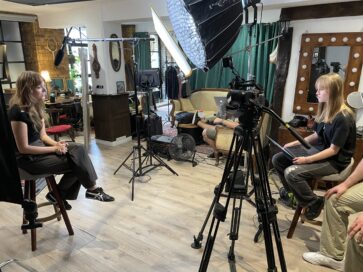How to Boost Open Day Attendance to Your School with Strategic Video Marketing
For independent schools in the UK, an open day isn’t just a date on the calendar — it’s the moment when prospective parents and pupils get to experience your school’s unique personality, ethos and offering in a tangible way. But in a crowded market, the challenge isn’t only to host a great open day; it’s to make sure the right families actually turn up.
That’s where strategic video production becomes a game-changer in education marketing.
Video is the most engaging digital format available to schools today. When used intelligently, it can not only raise awareness but also create a strong emotional connection before a parent even sets foot on your campus — a key advantage in student recruitment campaigns.
In this article, we’ll look at the most effective types of video to use, how to distribute them without breaking the budget, how to tailor them to different stages of the recruitment funnel, and how to incorporate calls-to-action that turn viewers into attendees.
Why Video Production is a Game-Changer for Open Day Recruitment
Professional — or even well-planned in-house — video production allows you to show your school, not just talk about it. Prospective parents can hear from your headteacher, watch pupils interact, and get a visual feel for your facilities and ethos — all from their phones or laptops. According to Wyzowl’s 2024 Video Marketing Statistics, 88% of people say a video convinced them to buy a product or service. For schools, that “purchase” is booking an open day slot.
In the context of education marketing for UK private schools, video works particularly well because:
- It conveys prestige and warmth simultaneously — essential for building trust with fee-paying families.
- It can reach parents who aren’t yet actively searching — planting the seed before they shortlist schools.
- It provides shareable content that alumni, current parents and local community groups can circulate.
Understanding the School Recruitment Marketing Funnel
Before you start filming, it’s important to recognise that not all prospective parents are in the same place on their decision-making journey. Broadly, there are two main audience segments:
- Aware Parents – They already know your school by name, may have visited your website or spoken to current parents, and are actively considering whether to attend your open day.
- Unaware Parents – They may not have heard of your school at all, or only vaguely. They’re not yet actively searching, but they fit your target profile.
The recruitment marketing funnel for schools has three broad stages:
- Top of Funnel (Awareness): Introduce the school to new audiences.
- Middle of Funnel (Consideration): Provide more detail and build trust.
- Bottom of Funnel (Decision): Drive direct action, such as booking the open day.
Your video production strategy should deliver the right content to each audience at the right stage. This approach is a cornerstone of effective student recruitment.
Tailoring Video for Unaware Parents
For this group, your aim is to capture attention and create curiosity. The focus should be on:
- School Story Brand Films that showcase ethos, values, and atmosphere.
- Subject or Activity Spotlights highlighting standout features (e.g., exceptional music department, award-winning sports teams).
- Targeted social media ads with short, high-impact clips designed to pique interest and lead them to your website.
At this stage, you’re not asking them to “book now” straight away. Instead, encourage them to learn more and discover why your school might be right for their child.
Tailoring Video for Aware Parents
These families are further down the funnel and need a compelling reason to act. Focus on:
- Headteacher or Admissions Invitation Videos with a personal, warm call-to-action.
- Parent and Pupil Testimonials addressing common questions or hesitations.
- Behind-the-Scenes Previews of what they’ll experience at the open day.
Here, urgency is your ally. Make your CTAs time-bound (“Join us on Saturday 12 October – spaces are limited”). These videos should remove the final barriers to attendance and complete the student recruitment journey from interest to commitment.
The Most Effective Types of Video for Driving Open Day Attendance
When planning your video production for education marketing, the key is to match your video type to the parent’s stage in the funnel.
(1) The “School Story” Brand Film
Purpose: Build emotional connection and position your school’s ethos.
Content: A 2–3 minute cinematic film featuring interviews with leadership, teachers, and pupils; sweeping drone shots of the grounds; and glimpses of classroom life.
Why it works: It gives parents the why behind choosing your school and encourages them to find out more — ideally by attending the open day.
(2) Parent & Pupil Testimonials
Purpose: Provide social proof and reassurance.
Content: Short (60–90 seconds) clips of parents explaining why they chose your school, or pupils sharing what they love most.
Why it works: UK parents often trust peer recommendations more than prospectuses. Hearing directly from other parents can overcome hesitations.
(3) Open Day Invitation Video
Purpose: Drive immediate action.
Content: A personable on-camera invite from the headteacher or admissions lead, outlining what’s special about the upcoming event. End with a clear date, time, and booking link.
Why it works: It’s direct, time-sensitive, and makes the open day feel like a personal invitation rather than a generic event.
(4) Subject or Activity Spotlights
Purpose: Showcase unique strengths.
Content: 30–60 second clips focusing on areas like performing arts, STEM facilities, or sports teams.
Why it works: They appeal to niche interests of certain families and may tip the balance for parents comparing schools.
(5) Behind-the-Scenes Social Clips
Purpose: Humanise the school.
Content: Informal smartphone videos from staff or pupils preparing for the open day, sneak peeks of displays, or rehearsal snippets from student performances.
Why it works: They create anticipation and make the school feel accessible rather than intimidating.
How to Distribute Video Effectively on a Budget
Even with a modest education marketing budget, you can make a significant impact if you focus on smart distribution.
(1) Leverage Social Media Algorithms
- Facebook & Instagram: Ideal for reaching local parents through both organic posts and targeted ads. Even £50–£100 in paid promotion can put your video in front of thousands of parents in your catchment area.
- LinkedIn: Useful for connecting with professional parents and alumni networks.
- TikTok & Instagram Reels: Increasingly relevant if your target families include younger parents or if you want to highlight pupil-led content.
Tip: Post natively to each platform rather than using cross-posting tools — algorithms reward native uploads with higher reach.
(2) Email Marketing with Embedded Thumbnails
Embed video links into your email newsletters to boost open and click-through rates. In student recruitment campaigns, subject lines that promise video content (e.g., “Your personal invitation to our Autumn Open Day [VIDEO]”) often outperform plain text.
(3) Your School Website Homepage
Feature your open day video prominently with a visible “Book Your Place” button — crucial for conversion in education marketing.
(4) Parent WhatsApp Groups and Local Forums
Leverage your existing community to share invitation videos and testimonials in relevant local groups.
(6) Press Releases to Local Media
Offer local outlets a video they can embed in coverage about your open day. This expands your reach with minimal spend.
Crafting Calls-to-Action That Get Results
Video production for student recruitment must always include a clear, compelling next step.
Golden rules for CTAs in school marketing videos:
- Be direct and specific – Instead of “Find out more”, say “Book your place for our Autumn Open Day on 12 October via the link below.”
- Repeat the CTA – Mention it at least twice.
- Use on-screen text – Reinforce spoken instructions visually.
- Create urgency – If spaces are limited, say so.
- Track and optimise – Use unique URLs or UTM codes to monitor results.
Maximising Impact with a Simple Timeline
Here’s a sample 6-week education marketing campaign plan:
- 6 weeks before: Release your “School Story” brand film (targeting unaware parents).
- 4 weeks before: Publish testimonials (targeting both audiences).
- 3 weeks before: Launch your headteacher’s direct invitation video (targeting aware parents).
- 2 weeks before: Share subject/activity spotlights (targeting unaware parents moving to consideration).
- Final week: Post daily behind-the-scenes teasers (targeting both audiences).
Measuring Success and Learning for Next Time
Track these key metrics:
- Views and watch time – gauge engagement.
- Click-through rates – measure CTA effectiveness.
- Actual attendance – the ultimate student recruitment KPI.
Analyse performance to refine your next video production plan.
Final Thoughts
A strong video production strategy isn’t about spending thousands on glossy films — it’s about telling the right stories, to the right people, at the right time. By creating a blend of emotional brand films, trust-building testimonials, and direct invitation videos — and by tailoring them to whether a parent knows your school or not — UK private schools can elevate their education marketing and drive more successful student recruitment outcomes.
In a competitive sector, a well-planned video campaign can be the difference between an open day with half-empty tours and one fully booked with families who already feel connected to your school before they arrive.

 How does the PA role differ in TV and film?
How does the PA role differ in TV and film?